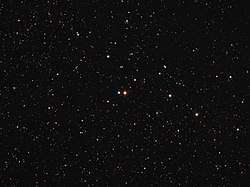WZ Cassiopeiae
WZ Cassiopeiae (WZ Cas) is a deep red hued star in the northern constellation of Cassiopeia. It is a variable star with a magnitude that ranges from 6.3 down to 8.8,[3] placing it near the limit of naked eye visibility at peak magnitude. The estimated distance to this star, as determined from its annual parallax shift of 2.0 mas,[1] is about 1,590 light years. It is moving closer to the Earth with a heliocentric radial velocity of −34 km/s.[6]
 WZ Cassiopeiae in optical light | |
| Observation data Epoch J2000 Equinox J2000 | |
|---|---|
| Constellation | Cassiopeia |
| Right ascension | 00h 01m 15.85670s[1] |
| Declination | +60° 21′ 19.0235″[1] |
| Apparent magnitude (V) | 7.04[2] (6.3 – 8.8)[3] |
| Characteristics | |
| Spectral type | C-N7 III: C2 2 Li 10[4] |
| U−B color index | +4.29[5] |
| B−V color index | +2.835±0.040[2] |
| Variable type | SRb[3] |
| Astrometry | |
| Radial velocity (Rv) | −34.0±2[6] km/s |
| Proper motion (μ) | RA: +10.740[1] mas/yr Dec.: −5.506[1] mas/yr |
| Parallax (π) | 2.0472 ± 0.0773[1] mas |
| Distance | 1,590 ± 60 ly (490 ± 20 pc) |
| Details | |
| Radius | ~600[7] R☉ |
| Luminosity | 12,400[8] L☉ |
| Temperature | 3,095[8] K |
| Other designations | |
| Database references | |
| SIMBAD | data |
This is an aging carbon star on the asymptotic giant branch.[7] Keenan (1993) assigned it a classification of C-N7 III: C2 2 Li 10, which indicates it is of the N star subtype in the revised Morgan–Keenan system, with a C2 strength index of 2 (a measure of the excess of carbon over oxygen) and an anomalously strong line of lithium at 6707 Å.[4] It is losing mass at the rate of 6.5×10−9 M☉ yr−1, which is on the low side for a star of this type. This is a semiregular variable of subtype SRb[3] with periods of 186 and 366 days due to radial pulsations.[7] It has expanded to around 600 times the Sun's radius and is radiating 17,392 times the Sun's luminosity from its photosphere at a relatively cool[10] effective temperature of 3,095 K.[8]
A magnitude 8.4 B-type visual companion, designated HD 224869, is located at an angular separation of 58″. The difference in the radial velocities for the two stars – 20 km/s – is too large for them to be dynamically associated.[11]
References
- Brown, A. G. A.; et al. (Gaia collaboration) (August 2018). "Gaia Data Release 2: Summary of the contents and survey properties". Astronomy & Astrophysics. 616. A1. arXiv:1804.09365. Bibcode:2018A&A...616A...1G. doi:10.1051/0004-6361/201833051.
- Anderson, E.; Francis, Ch. (2012). "XHIP: An extended hipparcos compilation". Astronomy Letters. 38 (5): 331. arXiv:1108.4971. Bibcode:2012AstL...38..331A. doi:10.1134/S1063773712050015.
- Samus', N. N; Kazarovets, E. V; Durlevich, O. V; Kireeva, N. N; Pastukhova, E. N (2017), "General catalogue of variable stars: Version GCVS 5.1", Astronomy Reports, 61 (1): 80, Bibcode:2017ARep...61...80S, doi:10.1134/S1063772917010085.
- Keenan, P. C. (1993). "Revised MK Spectral Classification of the Red Carbon Stars". Publications of the Astronomical Society of the Pacific. 105: 905. Bibcode:1993PASP..105..905K. doi:10.1086/133252.
- Mendoza v., Eugenio E.; Johnson, Harold L. (1965). "Multicolor Photometry of Carbon Stars". The Astrophysical Journal. 141: 161. Bibcode:1965ApJ...141..161M. doi:10.1086/148097.
- Wilson, Ralph Elmer (1953). "General catalogue of stellar radial velocities". Washington: 0. Bibcode:1953GCRV..C......0W.
- Lebzelter, T.; et al. (September 2005). "WZ Cas - variability on multiple time-scales". Astronomy and Astrophysics. 440 (1): 295–303. Bibcode:2005A&A...440..295L. doi:10.1051/0004-6361:20053076.
- Bergeat, J; Knapik, A; Rutily, B (2002). "Carbon-rich giants in the HR diagram and their luminosity function". Astronomy & Astrophysics. 390 (3): 967–986. Bibcode:2002A&A...390..967B. doi:10.1051/0004-6361:20020525.
- "WZ Cas". SIMBAD. Centre de données astronomiques de Strasbourg. Retrieved 27 August 2018.
- Alksnis, O.; Zacs, L. (May 1994), "The Violet Opacity in the Red Peculiar Stars (II). Spectral Analysis of the Cool Carbon Stars WZ CAS and V CYG", Astrophysics and Space Science, 215 (1): 73–82, Bibcode:1994Ap&SS.215...73A, doi:10.1007/BF00627461
- Herbig, George H. (June 1955). "HD 224869: an Optical Companion to WZ Cassiopeiae". Publications of the Astronomical Society of the Pacific. 67 (396): 181. Bibcode:1955PASP...67..181H. doi:10.1086/126798.